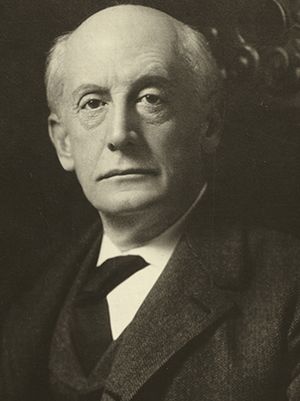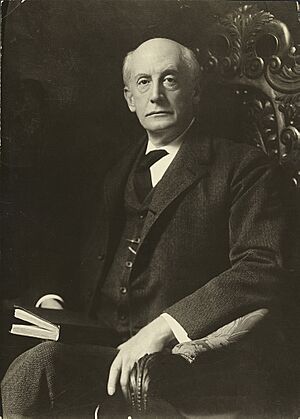Moorfield Storey facts for kids
Quick facts for kids
Moorfield Storey
|
|
|---|---|
 |
|
| Born | March 19, 1845 |
| Died | October 24, 1929 (aged 84) |
| Education |
|
| Organization | NAACP |
| 1st President of the National Association for the Advancement of Colored People (NAACP) | |
| In office 1909–1929 |
|
| Succeeded by | Joel Elias Spingarn |
| 18th President of the American Bar Association | |
| In office 1895–1896 |
|
| Preceded by | James C. Carter |
| Succeeded by | James M. Woolworth |
Moorfield Storey (born March 19, 1845 – died October 24, 1929) was an American lawyer and a strong leader for civil rights. He lived in Boston, Massachusetts. Storey believed in peace, was against countries taking over others, and thought all people should be treated equally.
He was the first president of the National Association for the Advancement of Colored People (NAACP). He led the NAACP from 1909 until he passed away in 1929. Storey also spoke out against the United States expanding its power, starting with the Spanish–American War.
Contents
Moorfield Storey's Early Life
Moorfield Storey was born in 1845 in Roxbury, Massachusetts. At that time, Roxbury was a town near Boston. His family came from the first Puritan settlers in New England. They were also closely involved in the movement to end slavery, called abolitionism.
Storey's father was a lawyer in Boston. Moorfield went to the Boston Latin School and finished in 1862. This was at the start of the Civil War. He then went to Harvard University, where he was part of the Glee Club. He graduated in 1866 and later studied at Harvard Law School.
His Career as a Lawyer
Storey started his own law firm in Boston, Massachusetts. It was called Storey, Thorndike, Palmer, Dodge. He also worked as an editor for the American Law Review from 1873 to 1879.
In 1896, he was chosen to be the president of the American Bar Association. This is a group for lawyers. He was also a member of the American Academy of Arts and Sciences. From 1913 to 1914, he was president of the Massachusetts Bar Association.
Storey was part of a political group called the "Mugwump" movement in 1884. He supported Grover Cleveland for president. He believed strongly in the gold standard for money and in people's right to make their own agreements. He built a house on Great Cranberry Island in 1887.
Fighting Against Imperialism
Moorfield Storey was against countries using their military to control other lands. He spoke at the first big meeting against imperialism in Boston in June 1898. This meeting happened because of the Spanish–American War.
He was a vice president of the New England Anti-Imperialist League. He also wrote a report for the Lodge Committee about bad actions during the Philippine–American War. From 1905 until 1921, Storey was the president of the Anti-Imperialist League. He felt that controlling other countries and treating people unfairly at home were connected.
Storey was known for working very long hours, even when he was older. He often fought for ideas that were not popular. He once said, "It is not success to fight on the winning side. It is success to fight bravely for a principle even if one does not live to see it triumph." This showed his strong will to fight for what was right, even if he didn't win every time.
Running for Congress
In 1900, Storey thought about running for president. But he decided it wasn't practical. Instead, he ran for Congress as an independent candidate. He lost, but his campaign was energetic and well-known. He ran on a platform that included being against imperialism, and supporting the gold standard and free trade.
A Champion for Civil Rights
Moorfield Storey loved a quote from his friend, Lord Russel. It said that true civilization means caring for the poor, respecting women, and seeing all people as brothers and sisters. It means reducing violence and loving freedom. Storey used this idea to guide his work for civil rights.
Storey was a strong supporter of civil rights for all people. This included African Americans, American Indians, and immigrants. He was against rules that limited immigration. He believed in equal rights for all races and that people should be able to govern themselves. He said, "When the white man governs himself, that is self-government, but when he governs himself and also governs another man, that is more than self-government–that is despotism."
Storey was the first president of the National Association for the Advancement of Colored People (NAACP). He led the group from its start in 1909 until his death in 1929. He helped the NAACP fight against unfair laws that treated people differently because of their race. These laws went against the Fourteenth and Fifteenth amendments.
He led several important legal victories for the NAACP. One famous case was Buchanan v. Warley in 1917. In this case, the Supreme Court decided that a law in Louisville that separated people by race in different city blocks was illegal.
Storey also worked with James Weldon Johnson to organize the 1919 National Conference on Lynching.
In 1920, Storey helped the NAACP defend the Elaine Twelve. These were men who were convicted of murder and faced the death penalty. The NAACP raised money for their defense. Storey worked with the legal team as some of these cases went to the United States Supreme Court. In the case of Moore v. Dempsey (1923), the Court made an important decision. It said that state criminal cases must follow the rules of fair legal process, as stated in the Due Process Clause of the Fourteenth Amendment to the United States Constitution.
Later Life and Legacy
In the 1920s, Storey was against the U.S. military being in Haiti and the Dominican Republic. He was the leader of the Haiti-Santo Domingo Independence Society.
He passed away in Lincoln, Massachusetts in 1929. He had four children with his wife, Gertrude Cutts, who had died in 1912.
Friendship with Edward Waldo Emerson
Storey was a long-time friend of Edward Waldo Emerson. Edward was the son of the famous American poet Ralph Waldo Emerson. Storey and Edward were in the same class at Harvard. After they graduated, Storey went on a camping trip with Edward and his father. The poet William Ellery Channing was also there.
During a storm on the trip, Storey sang to cheer everyone up. Edward joined in the chorus. Ralph Waldo Emerson wrote about this event in his journals. Storey and Edward remained friends for many years. They even wrote a book together in 1911 about United States Attorney General Ebenezer R. Hoar.
Working with Charles Sumner
From 1867 to 1869, Storey worked for the United States Senate Committee on Foreign Relations. He was also a private secretary to its chairman, Senator Charles Sumner. Storey's father introduced him to Sumner. Storey moved into the Senator's house after graduating from Harvard. He took the job to continue his law studies.
Storey spent two years as Senator Sumner's assistant and one of his few friends. Sumner was a progressive politician who had made many enemies in Washington. Storey was allowed to practice law in 1869.
Moorfield Storey is remembered as a role model for those who believe in individual freedom and civil rights.




